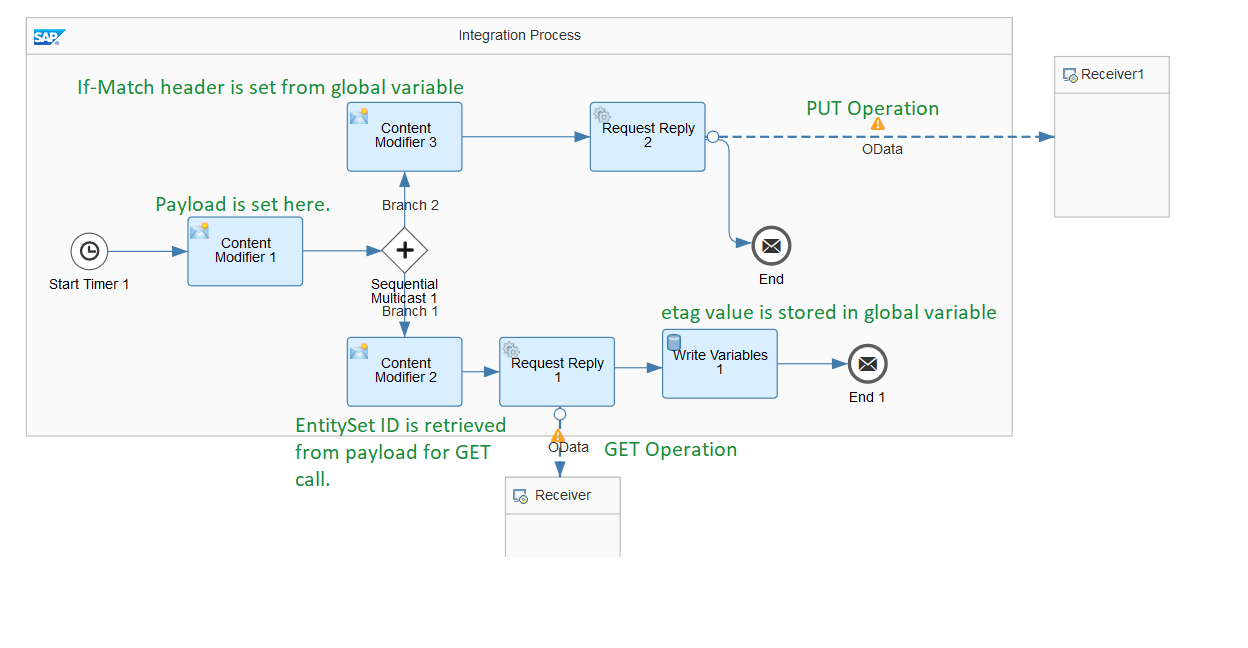
- SAP Community
- Products and Technology
- Technology
- Technology Blogs by SAP
- SAP Cloud Integration – OData V2 Conditional Updat...
Technology Blogs by SAP
Learn how to extend and personalize SAP applications. Follow the SAP technology blog for insights into SAP BTP, ABAP, SAP Analytics Cloud, SAP HANA, and more.
Turn on suggestions
Auto-suggest helps you quickly narrow down your search results by suggesting possible matches as you type.
Showing results for
saranya_baskara
Participant
Options
- Subscribe to RSS Feed
- Mark as New
- Mark as Read
- Bookmark
- Subscribe
- Printer Friendly Page
- Report Inappropriate Content
09-16-2018
5:49 AM
Introduction
The HTTP Protocol has a concept of conditional requests.
HTTP conditional requests are requests that are executed differently, depending on the value of specific headers like
If-MatchIf-Match can be used to prevent the modification of a resource without overriding another change that has been done since the original resource was fetched. If the request cannot be fulfilled, the 412(Precondition Failed) response is returned.How to achieve conditional update via OData V2 adapter in SAP Cloud Integration?
OData V2 adapte allows propagation of "If-Match" header to the receiver.
The value for the header "If-Match" has to be fetched by READ operation on the resource that is being updated.
Simple Update
The Update operation can be configured via PUT, MERGE or PATCH.
Assume the below service accepts only conditional Update. i.e., PUT operation requires "If-Match" header in the request.
https://services.odata.org/V2/(S(ifmatch))/OData/OData.svc/
Here we will update the Product with ID=1
The Update payload is as below
<Products>
<Product>
<ID>1</ID>
<Rating>5</Rating>
</Product>
</Products>Assume the GET of <serviceURL>/Products(ID=1) returns an Etag header that has to be passed in the If-Match header of PUT request.
- The Integration Flow is modeled with sequential multicast.
- Branch 1 does the GET request
- The Etag response header is stored using Write Variable.
- Branch 2 will set the "If-Match" header from the global variable from step 3. PUT operation is configured.

1. Content Modifier 1
The update payload is set in this content Modifier.
2. Sequential Multicast: Branch 1
2.1. Content Modifier 2
The value of the key property (ID) is stored from the update payload in exchange property "keyValue"

2.2. Request Reply 1
OData receiver is configured for GET call. ID is set from the exchange property "keyValue"

2.3. Write Variables 1
The response header "Etag" value is stored in global variable "etag".

3. Sequential Multicast: Branch 2
3.1. Content Modifier 3
If-Match exchange header is created with the value from global variable "etag".

3.2. Request Reply 2
OData receiver is configured for PUT call. The "If-Match" header set in Content Modifer 3 is passed to receiver endpoint and conditional PUT will be executed.

Update in Batch
- The Integration Flow is modeled with sequential multicast.
- Branch 1 does the GET request
- The Etag response header is stored using Write Variable.
- Branch 2 will set the "If-Match" header from the global variable from step 3.
- Message mapping maps the update payload to batch payload and sets the "If-Match" header in the batch Payload.

Message Mapping 1
- Map the batch payload for the entitySet and its properties.

- The headerName will be constant

- Click the header value. Create a script file.

- Define a function getHeader() to get the header value that is set in Content Modifier 3.

- Pass the constant "If-Match" as an argument to get the header value and assign it to headerValue.

- SAP Managed Tags:
- SAP Integration Suite,
- OData
Labels:
4 Comments
You must be a registered user to add a comment. If you've already registered, sign in. Otherwise, register and sign in.
Labels in this area
-
ABAP CDS Views - CDC (Change Data Capture)
2 -
AI
1 -
Analyze Workload Data
1 -
BTP
1 -
Business and IT Integration
2 -
Business application stu
1 -
Business Technology Platform
1 -
Business Trends
1,658 -
Business Trends
91 -
CAP
1 -
cf
1 -
Cloud Foundry
1 -
Confluent
1 -
Customer COE Basics and Fundamentals
1 -
Customer COE Latest and Greatest
3 -
Customer Data Browser app
1 -
Data Analysis Tool
1 -
data migration
1 -
data transfer
1 -
Datasphere
2 -
Event Information
1,400 -
Event Information
66 -
Expert
1 -
Expert Insights
177 -
Expert Insights
293 -
General
1 -
Google cloud
1 -
Google Next'24
1 -
Kafka
1 -
Life at SAP
780 -
Life at SAP
13 -
Migrate your Data App
1 -
MTA
1 -
Network Performance Analysis
1 -
NodeJS
1 -
PDF
1 -
POC
1 -
Product Updates
4,577 -
Product Updates
340 -
Replication Flow
1 -
RisewithSAP
1 -
SAP BTP
1 -
SAP BTP Cloud Foundry
1 -
SAP Cloud ALM
1 -
SAP Cloud Application Programming Model
1 -
SAP Datasphere
2 -
SAP S4HANA Cloud
1 -
SAP S4HANA Migration Cockpit
1 -
Technology Updates
6,873 -
Technology Updates
419 -
Workload Fluctuations
1
Related Content
- FAQ for C4C Certificate Renewal in Technology Blogs by SAP
- 10+ ways to reshape your SAP landscape with SAP Business Technology Platform - Blog 7 in Technology Blogs by SAP
- Consuming SAP with SAP Build Apps - Connectivity options for low-code development - part 2 in Technology Blogs by SAP
- Harnessing the Power of SAP HANA Cloud Vector Engine for Context-Aware LLM Architecture in Technology Blogs by SAP
- Business Process Integration and Assimilation in a M&A and How to Accelerate Synergy Savings. in Technology Blogs by SAP
Top kudoed authors
| User | Count |
|---|---|
| 35 | |
| 25 | |
| 14 | |
| 7 | |
| 7 | |
| 6 | |
| 6 | |
| 5 | |
| 4 | |
| 4 |